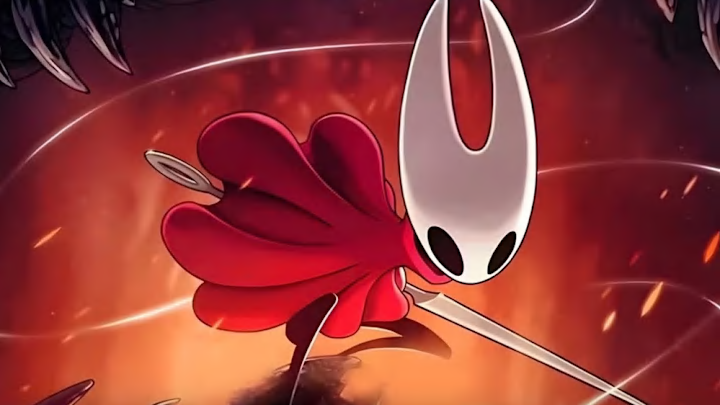I remember when my brother started playing this game called Hollow Knight a few years back. I had not strayed far from visual novels and farming sims at this time, but it caught my attention. It was a unique title, with little to no story exposition outside of what you found on your own, and a large, expansive map to freely explore. I tried playing the game myself after watching him for a while: I was bad at it. Hilariously so. That didn't stop me from watching him play the game for hours and even helping him discover what he had left to do to get the mythical 112% completion. It was captivating, and I still find myself enraptured by this world full of rich lore and challenging boss fights that anyone could enjoy, controller or not.
This was my first real introduction to the Metroidvania genre.
Now, with Hollow Knight: Silksong finally released and everyone so enraptured by this long-awaited sequel, myself included, I found myself thinking about the genre in a deeper light. It's incredibly popular, that much is obvious, but where did it start? How did it become what we know now, and, most importantly, how did it manage to carve its place in gaming despite seeming so particular and sometimes frustrating?
1. Metroid and Castlevania Paving the Path
Released on the Famicom back in 1986 in Japan, and later getting a North American release on the NES in 1987, Metroid was the first real glimpse into what the genre would become. It was a nonlinear action-adventure title, where the player, Samus, explores an alien planet and unlocks different areas by collecting new power-ups. That idea of not being restricted by linear progression was exciting and made experiencing the story much more natural and rich.
Around the same time, Castlevania would be released. Unlike Metroid, it was more structured in its story and gameplay. It was an action-platformer with a more linear map and progression system, and it wasn't until the release of Castlevania 2: Simon's Quest that we saw more of the features of Metroidvanias, mainly the large map that encouraged exploration and multiple endings depending on how you played. The popularization of these two games, thanks in part to their close release dates and similar mechanics and gameplay, has created the portmanteau commonly used to this very day to describe these titles.
2. What Makes a Metroidvania, Mechanically?
Like their predecessors, Metroidvanias are typically action-adventure titles. They aren't exclusive to each other, but this genre typically best supports Metroidvania mechanics and gameplay features, like the nonlinear storytelling. They're usually sidescrollers, with massive interconnected maps and multiple endings, which encourages exploration through puzzle platforming, backtracking with power-ups into previously locked areas, and challenging players with tight combat sequences against bosses.
As I mentioned, they're not exclusive, and as such, not all games in this genre share every single aspect; fans tend to disagree about what is required for a game to count as a Metroidvania at all.
A popular one, Ori and the Blind Forest, has a more linear story, something some might consider a core requirement. However, it still contains challenging platforming sections and power-ups that make exploring easier after unlocking them, like the ground pound and wall jump. Some also use an RPG equipment system to make traversal easier, like Blasphemous, but it can feel restricting in a genre all about discovery and freedom of exploration, since it prevents you from using them all at once.
3. What Makes a Metroidvania Enjoyable?
In a genre that can sometimes seem restrictive and challenging, it can seem difficult to break into when it comes to playing any title with that label. Metroidvanias tend to lean more into their tough and sometimes frustrating gameplay loop, but that is exactly why it has become such a standout genre over the last few decades. These games force players to slow down and pay attention, as well as challenge them with their learning curve. From puzzles to boss fights and even worldbuilding, it is a genre full of attention and care from development teams that put their all into their games, especially in the Indie scene.
Besides some titles from mainstream companies like Nintendo, a lot of the most recognizable titles come from Indie studios like Motion Twin, The Game Kitchen, and Videocult, some of which are much smaller teams than you would expect, considering how monumental game development actually is.
Silksong's developer, Team Cherry, has a core team of only 3 people! Despite having a list of features that help it to fall under the same umbrella of Metroidvania, it has more or less become one of the main genres for Indies to turn to because of experimentation. It can provide different approaches to development and promote a sense of exploration and discovery to those looking for a refreshing and challenging experience beyond the modern Triple A scene.
In short, Metroidvanias are a bit of an oddball in the gaming sphere, considering its inception was from a mixture of two games who shouldn't have much in common at first glance, but once you give it a try, you can discover a whole world of dedication, passion, challenge, and wholly unique gaming experiences waiting for you. I recommend all the games I mentioned here, but if you're looking for a more beginner-friendly introduction to the genre, Ori and the Blind Forest and Dead Cells are a great starting point for those unfamiliar and looking to finally give the genre a chance. I mean, we all know that Silksong is more than likely gonna win Game of the Year this year with the way it crashed most storefronts on launch, so better late than never!
